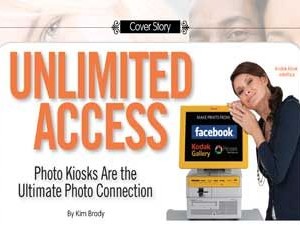
The digital revolution launched an exciting new era in communicating through pictures. In decades past, it was pro photographers and shutterbugs who were responsible for recording memorable events. Today, mobile phones and computing devices have put cameras into the hands of billions of people—from teens to senior citizens—many of whom had never carried a point-and-shoot camera.
Integrating these devices has provided consumers with virtually 24/7 access to their still and video capture, and those who own smartphones (an estimated 43% of mobile phone users) can share their images instantly via e-mail or post them to one of dozens of social networking and photo-sharing websites on the Internet.
With so many images being shared online, how do photo retailers take advantage of all this high-volume digital business? By providing direct access to social networks and image-hosting websites, today’s photo kiosks are providing the link photo retailers need to tap into social networking and photo-sharing websites, while providing customers with a much larger image pool from which to order prints, posters and photo gifts—all leading to a greater number of orders.
Several photo kiosk manufacturers have provided links to their company’s online photo management and printing services, but these are only helpful to existing customers who store their images on the manufacturer’s website. By linking in-store kiosks to high-traffic websites like Facebook, Flickr and Photobucket, manufacturers are expanding their reach and embracing popular culture by giving consumers direct access to the images they’ve uploaded to their favorite online communities.
Already this year, several photo kiosk manufacturers have announced new links to online albums.
Fujifilm North America Corporation announced upgrades to its latest kiosk at the CES show in January. “Fujifilm’s Multi-Service Kiosk offers the ability to access photos directly from a smartphone and from several online sources, including Facebook, Flickr and Picasa,” said Lenny Marano, senior business development manager, Imaging division. “All the user has to do is select the service they'd like, sign in to their account and select the photos they want, just as they would with a media card.
“It’s just as simple with an iOS-based smartphone,” he continued. “The user connects the phone to the kiosk, selects the photo folder on the screen and selects photos, again, just like they would with a typical media card.”
Customers will also be able to access images from Fujifilm’s online printing site, SeeHere.com, and use a new free-form composer to create their own custom products from a full suite of Fujifilm imaging products.
HP is upgrading kiosks at 2,600 locations, allowing Walmart and Meijer customers to order photo creative merchandise, in-store or online, for same-day pickup. Walmart customers will also be able to use HP’s in-store kiosks to access their photos from Snapfish.com (HP’s online service), Walmart.com and, soon, Facebook accounts. HP customers will also find it easier to share images within other social networks.
Snapfish.com also features a new online photo organizer that uses sophisticated algorithms to detect and identify people’s faces. Unlike similar applications, the Snapfish software can detect babies’ faces and track the changes as they grow, grouping their faces by individuals, despite the changes in facial features. Once a user tags certain people, the facial recognition feature recognizes them in subsequent photos, assigns the appropriate nametag and organizes them by groups.
Eastman Kodak’s Picture Kiosk was among the first to provide a link to the company’s own photo-sharing and printing website, Kodak Gallery. Last fall, the company announced new features from Picture Kiosk software, version 5.0. Among these is an enhanced Facebook application that allows customers to access images from their own Facebook albums, as well as those of their friends’ and shared Facebook albums (according to Facebook privacy rules). Kiosks with the new v5 software will also link to Google and Picasa websites where they can access images to create prints and/or personalized photo products.
“These new enhancements offer consumers easier access to their images, better tools for creating personalized products, and more choice and convenience in how they order and receive products,” said Larry Trevarthen, director of marketing for Kodak Picture Kiosks.
Note here that last month Kodak entered into an agreement with Shutterfly, a leading Internet-based social expression and personal publishing service, for the proposed sale of certain assets of Kodak Gallery. But you can be sure that Kodak’s 105,000 installed picture kiosks will continue to offer connectivity options for consumers to grab their photos from online sites.
Lucidiom introduced its APM Facebook connection in January 2011, with the release of its APM v7.5.1 software. Consumers can access their own Facebook accounts at the APM kiosks and use photos from one or more Facebook friends’ albums to make prints, photo books, calendars, cards and other products offered through the kiosk. Consumers can also upload as many as 200 pictures at a time from the kiosk to Lucidiom’s Photo Finale website or to their Facebook accounts and create posts to accompany the photos.
Lucidiom’s APM software also supports iOS Connect for BlackBerry and Android phones as well as Apple’s iOS Connect. Users simply plug in their iPhones to the kiosk and use images stored on the device to order any of the products offered on the APM kiosk.
Mitsubishi Electric Visual Solutions America integrated its Mini Photobook Maker with the DPS Kiosk 7000, enabling customers to use photo files from digital storage devices or social networking websites such as Facebook and Picasa to create pocket-sized mini photo books. The Mini Photobook maker compiles, prints and assembles 10- to 30-page books in minutes, with retail prices starting at less than $6—ideal for students and young adults on a budget who want to create inexpensive, personal gifts for families and friends.
“A mini photo book . . . is the perfect gift for family, friends and coworkers,” says Flora Bell, photo system business development manager for Mitsubishi Electric. “(And it presents) a real moneymaking opportunity for retail venues.”





